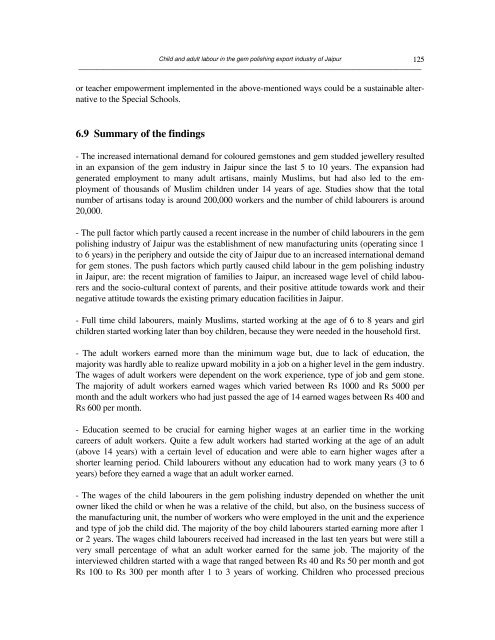Create successful ePaper yourself
Turn your PDF publications into a flip-book with our unique Google optimized e-Paper software.
<strong>Child</strong> <strong>and</strong> <strong>adult</strong> <strong>labour</strong> <strong>in</strong> <strong>the</strong> <strong>gem</strong> polish<strong>in</strong>g <strong>export</strong> <strong>in</strong>dustry <strong>of</strong> Jaipur<br />
──────────────────────────────────────────────────────────────────────────────────────────────<br />
or teacher empowerment implemented <strong>in</strong> <strong>the</strong> above-mentioned ways could be a susta<strong>in</strong>able alternative<br />
to <strong>the</strong> Special Schools.<br />
125<br />
6.9 Summary <strong>of</strong> <strong>the</strong> f<strong>in</strong>d<strong>in</strong>gs<br />
- The <strong>in</strong>creased <strong>in</strong>ternational dem<strong>and</strong> for coloured <strong>gem</strong>stones <strong>and</strong> <strong>gem</strong> studded jewellery resulted<br />
<strong>in</strong> an expansion <strong>of</strong> <strong>the</strong> <strong>gem</strong> <strong>in</strong>dustry <strong>in</strong> Jaipur s<strong>in</strong>ce <strong>the</strong> last 5 to 10 years. The expansion had<br />
generated employment to many <strong>adult</strong> artisans, ma<strong>in</strong>ly Muslims, but had also led to <strong>the</strong> employment<br />
<strong>of</strong> thous<strong>and</strong>s <strong>of</strong> Muslim children under 14 years <strong>of</strong> age. Studies show that <strong>the</strong> total<br />
number <strong>of</strong> artisans today is around 200,000 workers <strong>and</strong> <strong>the</strong> number <strong>of</strong> child <strong>labour</strong>ers is around<br />
20,000.<br />
- The pull factor which partly caused a recent <strong>in</strong>crease <strong>in</strong> <strong>the</strong> number <strong>of</strong> child <strong>labour</strong>ers <strong>in</strong> <strong>the</strong> <strong>gem</strong><br />
polish<strong>in</strong>g <strong>in</strong>dustry <strong>of</strong> Jaipur was <strong>the</strong> establishment <strong>of</strong> new manufactur<strong>in</strong>g units (operat<strong>in</strong>g s<strong>in</strong>ce 1<br />
to 6 years) <strong>in</strong> <strong>the</strong> periphery <strong>and</strong> outside <strong>the</strong> city <strong>of</strong> Jaipur due to an <strong>in</strong>creased <strong>in</strong>ternational dem<strong>and</strong><br />
for <strong>gem</strong> stones. The push factors which partly caused child <strong>labour</strong> <strong>in</strong> <strong>the</strong> <strong>gem</strong> polish<strong>in</strong>g <strong>in</strong>dustry<br />
<strong>in</strong> Jaipur, are: <strong>the</strong> recent migration <strong>of</strong> families to Jaipur, an <strong>in</strong>creased wage level <strong>of</strong> child <strong>labour</strong>ers<br />
<strong>and</strong> <strong>the</strong> socio-cultural context <strong>of</strong> parents, <strong>and</strong> <strong>the</strong>ir positive attitude towards work <strong>and</strong> <strong>the</strong>ir<br />
negative attitude towards <strong>the</strong> exist<strong>in</strong>g primary education facilities <strong>in</strong> Jaipur.<br />
- Full time child <strong>labour</strong>ers, ma<strong>in</strong>ly Muslims, started work<strong>in</strong>g at <strong>the</strong> age <strong>of</strong> 6 to 8 years <strong>and</strong> girl<br />
children started work<strong>in</strong>g later than boy children, because <strong>the</strong>y were needed <strong>in</strong> <strong>the</strong> household first.<br />
- The <strong>adult</strong> workers earned more than <strong>the</strong> m<strong>in</strong>imum wage but, due to lack <strong>of</strong> education, <strong>the</strong><br />
majority was hardly able to realize upward mobility <strong>in</strong> a job on a higher level <strong>in</strong> <strong>the</strong> <strong>gem</strong> <strong>in</strong>dustry.<br />
The wages <strong>of</strong> <strong>adult</strong> workers were dependent on <strong>the</strong> work experience, type <strong>of</strong> job <strong>and</strong> <strong>gem</strong> stone.<br />
The majority <strong>of</strong> <strong>adult</strong> workers earned wages which varied between Rs 1000 <strong>and</strong> Rs 5000 per<br />
month <strong>and</strong> <strong>the</strong> <strong>adult</strong> workers who had just passed <strong>the</strong> age <strong>of</strong> 14 earned wages between Rs 400 <strong>and</strong><br />
Rs 600 per month.<br />
- Education seemed to be crucial for earn<strong>in</strong>g higher wages at an earlier time <strong>in</strong> <strong>the</strong> work<strong>in</strong>g<br />
careers <strong>of</strong> <strong>adult</strong> workers. Quite a few <strong>adult</strong> workers had started work<strong>in</strong>g at <strong>the</strong> age <strong>of</strong> an <strong>adult</strong><br />
(above 14 years) with a certa<strong>in</strong> level <strong>of</strong> education <strong>and</strong> were able to earn higher wages after a<br />
shorter learn<strong>in</strong>g period. <strong>Child</strong> <strong>labour</strong>ers without any education had to work many years (3 to 6<br />
years) before <strong>the</strong>y earned a wage that an <strong>adult</strong> worker earned.<br />
- The wages <strong>of</strong> <strong>the</strong> child <strong>labour</strong>ers <strong>in</strong> <strong>the</strong> <strong>gem</strong> polish<strong>in</strong>g <strong>in</strong>dustry depended on whe<strong>the</strong>r <strong>the</strong> unit<br />
owner liked <strong>the</strong> child or when he was a relative <strong>of</strong> <strong>the</strong> child, but also, on <strong>the</strong> bus<strong>in</strong>ess success <strong>of</strong><br />
<strong>the</strong> manufactur<strong>in</strong>g unit, <strong>the</strong> number <strong>of</strong> workers who were employed <strong>in</strong> <strong>the</strong> unit <strong>and</strong> <strong>the</strong> experience<br />
<strong>and</strong> type <strong>of</strong> job <strong>the</strong> child did. The majority <strong>of</strong> <strong>the</strong> boy child <strong>labour</strong>ers started earn<strong>in</strong>g more after 1<br />
or 2 years. The wages child <strong>labour</strong>ers received had <strong>in</strong>creased <strong>in</strong> <strong>the</strong> last ten years but were still a<br />
very small percentage <strong>of</strong> what an <strong>adult</strong> worker earned for <strong>the</strong> same job. The majority <strong>of</strong> <strong>the</strong><br />
<strong>in</strong>terviewed children started with a wage that ranged between Rs 40 <strong>and</strong> Rs 50 per month <strong>and</strong> got<br />
Rs 100 to Rs 300 per month after 1 to 3 years <strong>of</strong> work<strong>in</strong>g. <strong>Child</strong>ren who processed precious


















